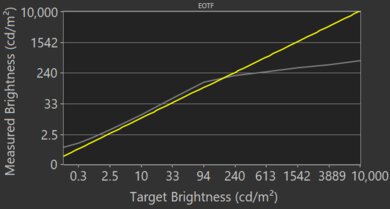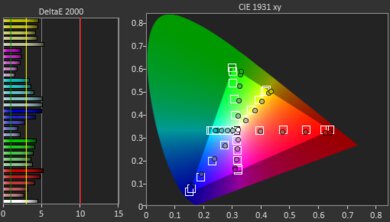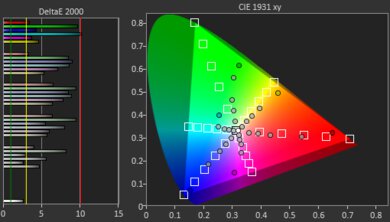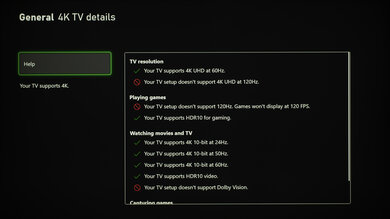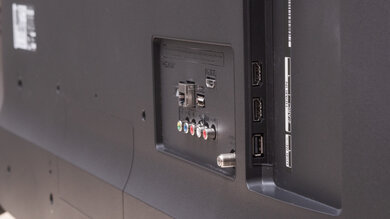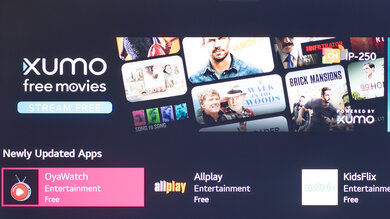The LG UN7000 is an entry-level budget TV that offers okay overall performance and has limited features. It's available in a wide range of sizes, and the larger models are sold as the LG UN7070. Most of the variants have IPS panels, including the 55 inch model we tested, but some sizes have VA panels, which are expected to perform differently. Our unit has fairly wide viewing angles, but that comes at the cost of its low contrast ratio. It also has uniformity issues, but this may vary between units. Unfortunately, it offers a limited HDR experience as it fails to display a wide color gamut, has mediocre HDR peak brightness, and there are some artifacts when displaying native 4k content. On the upside, most casual gamers should enjoy its low input lag and decent response time.
Our Verdict
The LG UN7000 is an okay TV for a variety of uses. It has fairly wide viewing angles, so it's well-suited to watching TV or sports with a group. That comes at the expense of a mediocre contrast ratio, which makes it less suitable for watching movies in the dark since blacks end up looking gray. Its low input lag is great for gaming and use as a PC monitor, but its response time is only decent, so fast-moving content may have some motion blur.
- Great reflection handling.
- Incredibly low input lag.
- Wide viewing angles.
- Can't display wide color gamut for HDR content.
- Doesn't get very bright.
- Low contrast ratio.
The LG UN7000 is disappointing for watching movies. The IPS panel on our model has a mediocre contrast ratio and bad black uniformity, resulting in blacks that look gray in the dark. There's also no local dimming feature to improve the black level. On the upside, it upscales lower-resolution content well, although there are some artifacts with native 4k content.
- Upscales lower-resolution content well.
- Some artifacts displaying 4k content.
- Low contrast ratio.
- No local dimming.
The LG UN7000 is decent for watching TV shows. It has decent viewing angles, so the image remains fairly accurate when viewed from an angle, which is great for watching with others. It also has great reflection handling, but unfortunately, it doesn't get very bright, so it may struggle a bit in bright rooms.
- Great reflection handling.
- Wide viewing angles.
- Upscales lower-resolution content well.
- Some artifacts displaying 4k content.
- Doesn't get very bright.
The LG UN7000 is decent for watching sports. It has wide viewing angles that are great for watching the big game with a group of friends. Despite having great reflection handling, it doesn't get bright enough to combat glare. Unfortunately, even though it has a decent response time, there's visible image duplication in motion because of the backlight's 120Hz flicker.
- Great reflection handling.
- Wide viewing angles.
- Decent response time.
- Duplication in motion due to 120Hz flicker.
- Doesn't get very bright.
The LG UN7000 is a decent TV for playing video games. It has a low input lag that makes gaming feel responsive, and its response time is decent, but there's still some image duplication in fast-moving scenes. Unfortunately, it doesn't have variable refresh rate (VRR) support, which may disappoint more serious gamers.
- Great reflection handling.
- Incredibly low input lag.
- Decent response time.
- Duplication in motion due to 120Hz flicker.
- Low contrast ratio.
- No VRR.
The LG UN7000 is a disappointing TV for watching movies in HDR. The model we tested uses an IPS panel with a mediocre contrast ratio, so blacks are not as deep as they should be, and it lacks local dimming to further deepen blacks. It also has mediocre brightness in HDR, which means that highlights don't pop enough for a satisfying HDR experience.
- Upscales lower-resolution content well.
- Can't display wide color gamut for HDR content.
- Doesn't get very bright.
- Low contrast ratio.
- No local dimming.
The LG UN7000 is an okay TV for HDR gaming. It has an incredibly low input lag, especially with HDR, so gaming feels responsive. However, the TV's low contrast ratio, lack of local dimming, and limited HDR brightness mean that highlights don't quite pop as they should in HDR. On the upside, it has a decent response time, although there's still some image duplication in fast-moving scenes.
- Incredibly low input lag.
- Decent response time.
- Can't display wide color gamut for HDR content.
- Doesn't get very bright.
- Low contrast ratio.
The LG UN7000 is good for use as a PC monitor. It can display proper chroma 4:4:4, which helps to render text clearly. It also has a remarkably low input lag, resulting in a responsive desktop experience. Its viewing angles are fairly wide, so the edges of the screen don't look washed out when sitting up close. Unfortunately, it doesn't get bright enough to combat glare, but it handles reflections well.
- Great reflection handling.
- Incredibly low input lag.
- Wide viewing angles.
- Duplication in motion due to 120Hz flicker.
- Doesn't get very bright.
Changelog
- Updated Jul 23, 2021: Added real content videos to Local Dimming.
- Updated Mar 01, 2021: Verified that 1440p is a native resolution.
- Updated Mar 01, 2021: Converted to Test Bench 1.6.
- Updated Jan 27, 2021: Updated review for accuracy and clarity.
Check Price
Differences Between Sizes And Variants
We tested the 55 inch LG UN7000 (55UN7000PUB) and we expect our results to be valid for the 43 inch (43UN7000PUB), 49 inch (49UN71006LB), 65 inch (65UN7000PUD), and 75 inch (75UN7070PUC) models too. The 50, 60, and 70 inch models are expected to have a VA panel, providing a better contrast ratio but at the cost of narrower viewing angles. In Europe, this TV is sold as the UN7100, and it's available in different sizes than in the United States; you can see the differences below.
| Size | Panel | US | Europe |
| 43" | IPS | 43UN7000PUB | 43UN71006LB |
| 49" | IPS | - | 49UN71006LB |
| 50" | VA | 50UN7000PUC | - |
| 55" | IPS | 55UN7000PUB | 55UN71006LB |
| 60" | VA | 60UN7000PUB | 60UN71006LB |
|
65" |
IPS | 65UN7000PUD | 65UN71006LB |
| 70" | VA | 70UN7070PUA | 70UN71006LA |
| 75" | IPS | 75UN7070PUC | 75UN71006LC |
If someone comes across a different type of panel or if their UN7000 or UN7070 doesn't correspond to our review, let us know and we'll update the review. Note that some tests, like gray uniformity and contrast, may vary between individual units.
The unit we tested was manufactured in July 2020 and you can see the label here.
Popular TV Comparisons
The LG UN7000 is a basic TV that doesn't stand out against its competition. It has trouble displaying native 4k content, and there are better options out there than can display 4k content properly, like the LG UN7300. See our recommendations for the best budget TVs, the best LG TVs, and the best 4k TVs.
The Samsung TU7000 is better overall than the LG UN7000, but they use different panel types. The Samsung has a VA panel, so the contrast ratio is much better. The Samsung also displays 4k content properly, while the LG uses a sub-pixel layout that can't display a perfect 4k image. However, the IPS panel on the LG has a wider viewing angle, and the LG has better reflection handling, which is great for well-lit rooms.
The LG UN7300 and the LG UN7000 perform similarly overall. Each TV is available with either a VA or IPS panel, which affects performance, but we reviewed ones with IPS panels. The UN7300 gets brighter in SDR, it has better reflection handling, and it displays native 4k content without issue. However, the UN7000 gets brighter in HDR and has wider viewing angles.
The Sony X750H is better than the LG UN7000 for most uses, but the TVs we reviewed each have different panel types. The Sony has a VA panel, so it has a significantly better contrast ratio, making it better for watching movies in the dark. It also does a better job at displaying 4k content, and it displays a wide color gamut for HDR content. However, the LG has wider viewing angles because of its IPS panel. It also handles reflections better and gets brighter in HDR.
The Samsung TU8000 is much better than the LG UN7000, but they use different panels with different advantages and disadvantages. The Samsung uses a VA panel with a much higher contrast ratio than the LG, while the LG uses an IPS panel with wider viewing angles. The Samsung feels better built overall, gets brighter in SDR, displays native 4k content properly, and has a lower input lag. The LG, on the other hand, gets brighter in HDR and handles reflections better.

We buy and test dozens of TVs yearly, taking an objective, data-driven approach to deliver results you can trust. Our testing process is complex, with hundreds of individual tests that take over a week to complete. Most of our tests are done with specially designed test patterns that mimic real content, but we also use the same sources you have at home to ensure our results match the real-world experience. We use two main tools for our testing: a Colorimetry Research CR-100 colorimeter and a CR-250 spectroradiometer.
Test Results

The LG UN7000 looks similar to the LG UN6950. It has thick bezels, a plain design, and no cable management. There's nothing that stands out about it, but at the same time, there's nothing wrong with its design. It's very simple, which is expected from a budget TV.
The back of the TV is basic and the plastic on it has a slightly textured finish to it. It comes with a strap to tie cables together, but there's no cable management.
The LG UN7000 has a mediocre contrast ratio, but this is expected from an IPS panel. Blacks appear closer to gray when viewed in the dark. Note that contrast ratio can vary between units.
Note: The 43, 49, 55, 65, and 75 inch models of this TV have an IPS panel, which results in lower contrast. However, the 50, 60, and 70 inch models have a VA panel, so they should have a much better contrast ratio, much like the LG UN6950.
This TV has disappointing peak brightness. It doesn't get bright enough to combat glare. It stays consistent with different content, but it quickly loses its brightness as images stay on the screen for longer, as seen in the difference between the peak and sustained window results.
We measured the SDR peak brightness after calibration in the 'Expert (Dark Room)' Picture Mode with Backlight at max, and all other image processing disabled.
If you want the brightest image possible, set the Picture Mode to 'Vivid'. We were able to get 549 cd/m² in the 10% peak window test. Note that the 'Vivid' mode disables most picture settings.
Update 07/23/2021: Added the real content videos.
There's no local dimming feature on this TV. The video is for reference only, so you can see how backlight on this display performs and compare it to a similar product with local dimming.
Update 07/23/2021: Added the real content videos.
There's no local dimming feature on this TV. The video is for reference only, so you can see how backlight on this display performs and compare it to a similar product with local dimming.
The HDR peak brightness is mediocre. This TV gets brighter in HDR than in SDR, but it's still not enough to truly bring out highlights. Luckily, it doesn't lose its brightness across varied content.
We measured the HDR peak brightness in the 'HDR Cinema' Picture Mode with Contrast and Backlight at their max. If you want an even brighter image, use these same settings in the 'HDR Vivid' Picture Mode. We got 525 cd/m² in the 10% peak window test.
The gray uniformity is okay, but this may vary between units. There's visible vignetting along the edges and corners, and there's dirty screen effect in the center, which may be distracting during sports. In near-dark scenes, the uniformity is much better.
This TV has bad black uniformity, but this may vary between units. There's noticeable clouding and backlight bleed in the corners. This can be distracting in dark scenes. If you often watch TV in a dark room, check out the Vizio V Series 2020, as it has significantly better black uniformity.
As is expected with an IPS panel, the LG UN7000 has wide viewing angles. This is ideal for fairly wide seating arrangements.
Note: The 43, 49, 55, 65, and 75 inch models of this TV have an IPS panel, which results in wide viewing angles. However, the 50, 60, and 70 inch models have VA panels, so they should have narrower viewing angles.
The reflection handling is great, but it's not as good as the LG UN7300. It performs well in moderately-lit rooms, but the reflections may get too distracting if there's direct sunlight on it.
The LG UN7000 has okay out-of-the-box color accuracy, but this is something that may vary between units. Most colors are inaccurate and white balance is off. Fortunately, the color temperature is very close to the 6500K target. Gamma doesn't follow the target curve all that well, as most scenes are darker than intended, and some scenes are brighter.
After calibration, the color accuracy is fantastic. Gamma follows the curve perfectly and white balance is almost perfect. Sadly, the color temperature is a bit cold, so some colors still have a blue-ish tint to them.
You can see our recommended settings here.
The LG UN7000 uses an RGBW sub-pixel structure, which is less accurate and doesn't display a perfect 4k image. Artifacts are noticeable in the tiles of the roof and the folds of the sails, and small text appears slightly blurry. If you want a budget-friendly TV that upscales 4k content better, check out the Hisense H6570G.
The LG UN7000 has an okay color gamut, but it's not considered a wide color gamut for HDR content. It has good coverage of the commonly-used DCI P3 color space, but disappointing coverage of the wider Rec. 2020.
The EOTF follows the target curve fairly well until it rolls off at its peak brightness, but most scenes are slightly too bright. The image is brighter in 'Game' mode, as seen in this EOTF.
If you find HDR too dim, use the 'Cinema HDR' Picture Mode with Dynamic Contrast set to 'High', Contrast and Backlight at their max, and enable Dynamic Tone Mapping. This results in a slightly brighter image, as seen in this EOTF.
This TV has poor color volume. It fails to display dark, saturated colors well because of the low contrast ratio and lack of color gamut.
Note: The 43, 49, 55, 65, and 75 inch models have an IPS panel like the one we tested. However, the 50, 60, and 70 inch models have a VA panel. We expect the VA panel models to have a better contrast ratio and should result in a slightly better color volume, similar to the LG UN6950.
There's some very minor image retention immediately after displaying our high-contrast static image, but it disappears quickly. This shouldn't be too much of an issue, and this may vary between units, so your experience can be different.
Although some IPS panels can suffer from temporary image retention like this one, this doesn't appear to be permanent as the IPS panel in our long-term test appears immune.
The LG UN7000 has a decent response time. There's some overshoot in the darker transitions, which may result in motion artifacts in dark scenes. Due to the backlight's 120Hz flicker, there's noticeable duplication in motion.
If you want a similar TV with a faster response time, check out the Toshiba Fire TV 2020.
This TV doesn't have a Black Frame Insertion feature.
This TV can interpolate content up to 60fps, a feature known as the 'Soap Opera Effect'. The motion interpolation feature works well and smooths motion out, but there are visible artifacts in busy scenes. Also, there's duplication in motion due to the backlight's 120Hz flicker.
Learn more about the motion interpolation settings here.
Since the TV has a slower response time, there isn't much stutter with lower-frame rate content, which is great.
The LG UN7000 can remove judder from native 24p content, like Blu-rays or native apps. However, it can't remove judder from 60p or 60i sources. To remove judder, enable Real Cinema. If you want a similar TV that can remove judder from all sources, check out the LG UP8000.
This TV doesn't support any variable refresh rate technology.
The LG UN7000 has an incredibly low input lag. You have to be in 'Game' mode to achieve the lowest input lag possible. There's also an 'Auto Low Latency Mode' that automatically switches the TV into 'Game' mode when you launch a game from a compatible device. Enable Instant Game Response for it to work.
If you plan on using this TV as a computer monitor and want low input lag, simply set the input icon to 'PC'.
The LG UN7000 supports most common resolutions at 60Hz. It can also display chroma 4:4:4, which is important for reading text. You have to set the input icon to 'PC' to display it. The TV supports 1080p @ 120Hz, but it skips every second frame. It also supports 1440p @ 120Hz, but it doesn't properly display an image, which is similar to what we experienced with the LG UN7300, as you can see in this image from the UN7300.
To achieve full bandwidth, enable HDMI Ultra HD Deep Color.
LG dropped DTS decoding from their 2020 lineup, so this TV only supports Dolby Digital via ARC or optical.
The LG UN7000's frequency response isn't bad. It has a well-balanced sound profile that results in clear dialogue, but it doesn't produce much bass. It gets loud, but you may notice compression artifacts at its max volume. If built-in speakers are important to you, check out the Samsung TU7000.
This TV has sub-par distortion performance. There isn't much distortion at moderate listening levels, but it gets a lot more noticeable at its max volume. However, not everyone may hear this, and it depends on the content.









